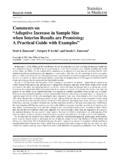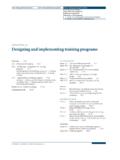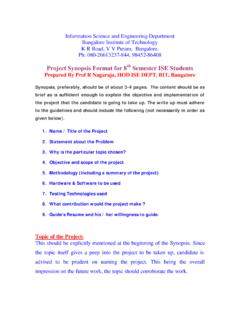Transcription of Designing, Monitoring, and Analyzing Group …
1 designing , monitoring , and Analyzing Group sequential ClinicalTrials Using theRCTdesignPackage forRDaniel L. Gillen1 Department of Statistics, University of California, Irvine, USAandScott S. EmersonDepartment of Biostatistics, University of Washington, Seattle, WA, USAJune 4, 2012 AbstractThe use of Group sequential methodology has become widespread in the conduct of clinic trials. As each clinicaltrial presents unique scientific, statistical and logistical constraints, it is important to carefully evaluate candidategroup sequential designs to ensure desirable operating characteristics. At the implementation stage of a clinical trialdesign it is also essential to account for deviations from original design specifications in order to control operatingcharacteristics such as type I and II error rates.
2 These changes might include the number and/or timing of analyses aswell as deviations from the originally assumed variability of outcome measures . Due to the computational complexityinvolved in evaluating, monitoring , and Analyzing a Group sequential procedure, specialized software is required. Inthe current manuscript we demonstrate how theRCTdesignpackage ( ) inRcan be used to select,implement, and analyze a Group sequential stopping rule. Throughout, we illustrate trial design and monitoring inthe context of a Group sequential survival trial of an experimental monoclonal antibody in patients with relapsedchronic lymphocytic IntroductionThe use of Group sequential methodology has become widespread in the conduct of clinic trials.
3 Many authorshave addressed the design (Pocock, 1977; O Brien and Fleming, 1979; Whitehead and Stratton, 1983; Wangand Tsiatis, 1987; Emerson and Fleming, 1989), implementation (Lan and DeMets, 1983, Burington and1 Corresponding author:Daniel L. GillenDepartment of Statistics2226 Donald Bren HallUniversity of California, IrvineIrvine, CA 92697-1250e-Mail: +1-949-824-9862 Fax: +1-949-824-9863 Group sequential Clinical Trial Design with theRCTdesignPackage, 2 Emerson, 2003), and analysis (Whitehead, 1986b; Emerson and Fleming, 1990) of Group sequential the general case, a stopping rule is defined for a schedule of analyses occurring at timest1,t2, .. ,tJ,which may be random. Often, the analysis times are in turn defined according to the statistical informationavailable at each analysis.
4 In the case of a statistical model that has statistical information proportional tothe sample size accrued to the study, such an approach is equivalent to defining the sample sizesN1,N2,.. ,NJat which the analyses will be performed. Forj= 1,..,J, we calculate a specified test statisticTjbased on observations available at timetj. The outcome space forTjis then partitioned into stopping setSjand continuation setCj. Starting withj= 1, the clinical trial proceeds by computingTj, and ifTj Sj,the trial is stopped. Otherwise,Tjis in the continuation setCj, and the trial gathers additional observationsuntil timetj+1. By choosingCJ= , the empty set, the trial must stop at or before theJ-th of the most commonly used Group sequential stopping rules are included if we consider continuationsets of the formCj= (aj,bj] [cj,dj) such that aj bj cj dj.
5 Quite often, theseboundaries are interpreted as the critical values for a decision rule. For instance, in a clinical trial comparingtwo active treatments A and B, test statistics less thanajmight correspond to decisions for the superiorityof treatment A, test statistics exceedingdjmight correspond to decisions for the inferiority of treatment A,and test statistics betweenbjandcjmight correspond to decisions for approximate equivalence between thetwo each clinical trial presents unique scientific, statistical and logistical constraints, it is important tocarefully evaluate candidate Group sequential designs to ensure desirable operating characteristics. Emersonet al. (2007b) describe a variety of frequentist design characteristics which might be examined in the mostcommonly encountered statistical problems.
6 Among them are1. The scientific measures of treatment effect which will correspond to early termination for futility The sample size requirements as described by the maximal sample size and summary measures of thesample size distribution ( , mean, 75th percentile) as a function of the hypothesized treatment The probability that the trial would continue to each analysis as a function of the hypothesized treat- Group sequential Clinical Trial Design with theRCTdesignPackage, 3ment The frequentist power to reject the null hypothesis as a function of the hypothesized treatment effect,with the type I error corresponding to the power under the null The frequentist inference (adjusted point estimates, confidence intervals, and P values)
7 Which wouldbe reported were the trial to stop with results corresponding exactly to a the implementation stage of a clinical trial design it is also essential to account for deviations fromoriginal design specifications in order to control operating characteristics such as type I and II error rates(Lan and DeMets, 1983, Burington and Emerson, 2003). These changes might include the number and/ortiming of analyses as well as deviations from the originally assumed variability of outcome measures. Finally,at the completion of a Group sequential test it is important that point and interval estimates be adjusted toaccount for bias that arises through repeated testing, particularly when the implemented stopping boundariesallow for early stopping under more modest effect sizes (Whitehead, 1986b; Emerson and Fleming, 1990).
8 Due to the computational complexity involved in evaluating, monitoring , and Analyzing a Group sequentialprocedure, specialized software is required. Multiple software packages can be used for the design and/oranalysis of Group sequential trials (PEST, 2000; EaSt, 2000; SAS/SEQDESIGN, 2011). TheRCTdesignpackage ( ) forRstatistical software is an extension of theSeqTrialmodule forSPlus(S+SeqTrial, 2002).RCTdesignis a comprehensive package that allows users to choose from a full array ofpreviously proposed Group sequential stopping rules, monitor an ongoing trial using standard constrainedboundaries techniques, and report bias adjusted results at the conclusion of a clinical the current manuscript we demonstrate how theRCTdesignpackage can be used to select, implement,and analyze a Group sequential stopping rule.
9 Throughout, we illustrate trial design and monitoring in thecontext of a clinical trial of an experimental monoclonal antibody in patients with relapsed chronic lympho-cytic leukemia. Section 2 provides an evaluation of candidate clinical trial designs based upon commonlyconsidered frequentist operating characteristics. Section 3 describes previously proposed methods for flex-ibly monitoring a Group sequential test. An example implementing the constrained boundaries algorithm(Burington and Emerson, 2003) is presented and adjusted inference is discussed. In Section 4, we presentadditional issues that should be considered when designing and monitoring a clinical trial to investigate anGroup sequential Clinical Trial Design with theRCTdesignPackage, 4intervention for which the effect may be hypothesized to vary with the duration of time since 5 concludes with a discussion of the importance of thorough evaluation in the selection of a groupsequential stopping rule along with areas of current and future Evaluation of a Group sequential Trial for a Censored Time-To-Event EndpointIn this section we illustrate the evaluation of statistical operating statistics in the context of a random-ized, double-blind.
10 Placebo-controlled clinical trial of an experimental monoclonal antibody in patients withrelapsed chronic lymphocytic leukemia (CLL). Treatment of CLL tends to focus on controlling disease symp-toms through the use of chemotherapy, radiation therapy, biological therapy, or bone marrow there have been multiple trials to assess the efficacy of treating CLL via monoclonal antibodiesthat target markers which are heavily expressed by CLL cells. In one of these trials, patients with relapsedCLL were randomly assigned to receive an experimental antibody or placebo, in addition to a standardchemotherapeutic regime. The intervention was administered intravenously once a week for four weeks andpatients were followed for the primary endpoint of overall survival.








